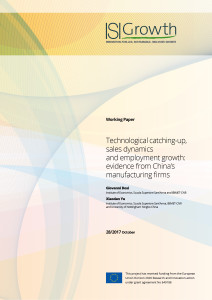This paper investigates the microeconomics of employment dynamics, using a Chinese manufacturing firm-level dataset over the period 1998-2007. It does so in the light of a scheme of “circular and cumulative causation”, whereby firms’ heterogeneous productivity gains and sales dynamics, and innovation activities ultimately shape the patterns of employment dynamics. Using firm’s productivity growth as a proxy for process innovation, our results show that the latter correlates negatively with firm-level employment growth. Conversely, relative productivity levels, as such a general proxy for the broad technological advantages/disadvantages of each firm, do show positive effect on employment growth in the long-run through replicator-type dynamics. Moreover, firm-level demand dynamics play a significant role in driving employment growth, which more than compensate the labour-saving effect due to technological progress. Finally, and somewhat puzzlingly, the direct effects of product innovation and patenting activities on employment growth appear to be negligible.

Technological catching-up, sales dynamics and employment growth: evidence from China’s manufacturing firms
Institute of Economics, Scuola Superiore Sant’Anna and IBIMET-CNR
Xiaodan Yu
Institute of Economics, Scuola Superiore Sant’Anna, IBIMET-CNR and Nottingham University Business School China, University of Nottingham Ningbo China
